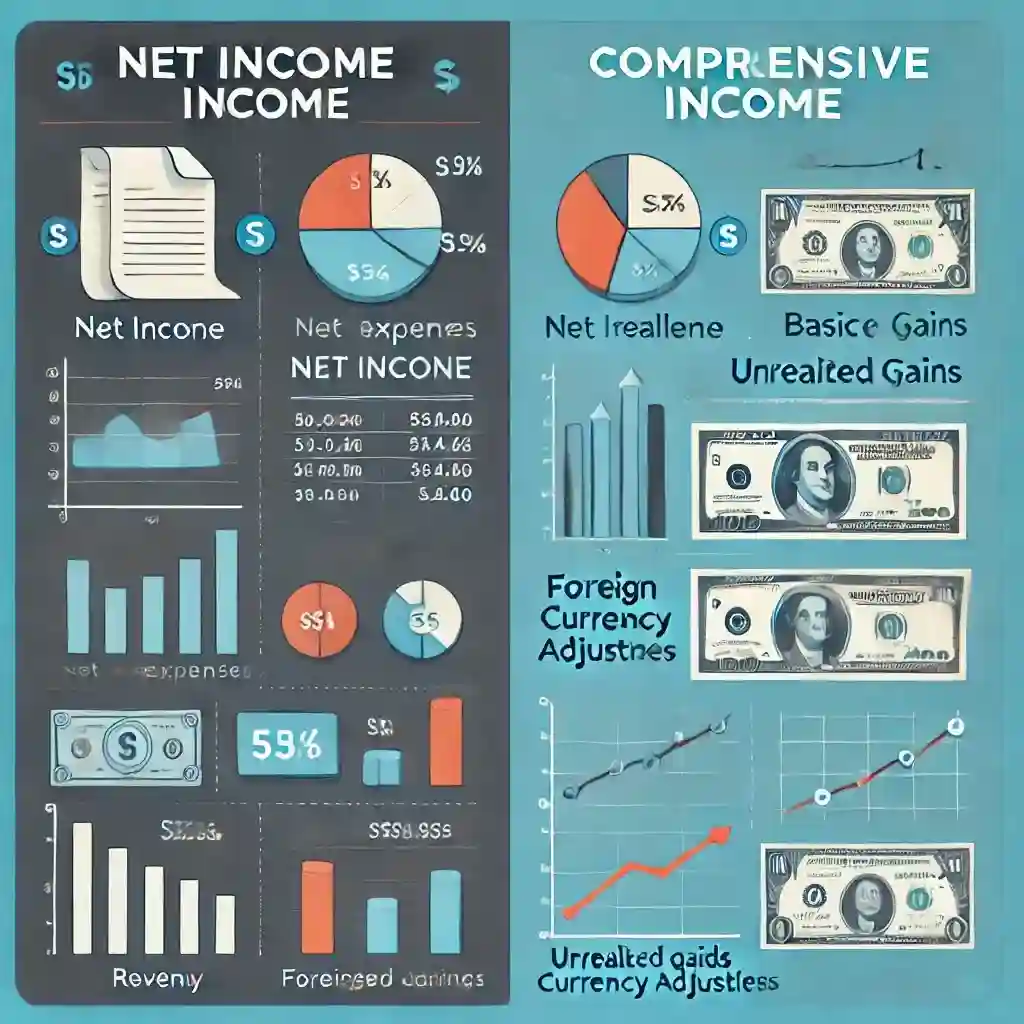A comprehensive income statement format provides businesses with a broader financial perspective beyond net income.
It includes realized and unrealized gains and losses, offering insights into a company’s financial health, compliance, and investment stability.
Understanding this format is crucial for business owners, CFOs, accountants, investors, and compliance officers who rely on accurate financial data for decision-making.
Unlike a standard income statement, which focuses on operational revenue and expenses, a statement of comprehensive income template factors in foreign currency adjustments, unrealized investment gains or losses, and pension plan adjustments.
For businesses working with an accounting firm, this ensures a more complete financial narrative, essential for navigating IFRS and GAAP compliance.
Simplify Your Tax Management Today!
Partner with Procheck today to unlock your business’s full potential. Our team of experts is ready to help you navigate taxation challenges and achieve your strategic goals.
Request a Free Consultation
Get started with a no-obligation consultation to discover how we can transform your financial operations.
Why Understanding the Comprehensive Income Statement Format Matters
✔ Regulatory Compliance: Ensures businesses meet IFRS and GAAP standards for transparent reporting.
✔ Informed Decision-Making: CFOs and financial managers can assess risks and plan investments effectively.
✔ Investor Confidence: Provides investors with a full financial picture beyond net earnings.
✔ Accurate Tax Planning: Helps businesses report all financial gains and losses correctly.
✔ Strategic Business Growth: Startups and SMEs can leverage financial insights for expansion and risk mitigation.
5 Steps to Understanding the Comprehensive Income Statement Template
1. Net Income vs. Comprehensive Income

One of the most significant differences in financial reporting is between net income and comprehensive income statement format.
- Net Income: Represents earnings after expenses, taxes, and costs are deducted from revenue.
- Comprehensive Income: Includes net income plus other unrealized financial components such as foreign exchange gains/losses and investment fluctuations.
Why Does This Matter?
✔ Net income reflects short-term profitability, while comprehensive income statement format gives a long-term financial perspective—vital for investors and strategic planning.
2. Items Included in Other Comprehensive Income (OCI)
Other Comprehensive Income (OCI) refers to financial transactions not yet realized but still impacting the company’s financial position.
Common OCI Items
✔ Unrealized Gains/Losses on Investments – Changes in asset values not yet sold.
✔ Foreign Currency Translation Adjustments – Financial impact due to currency fluctuations.
✔ Pension Plan Adjustments – Changes in long-term employee benefits.
OCI components may not affect daily business operations but play a critical role in determining long-term financial stability.
3. Reporting and Presentation Requirements
IFRS vs. GAAP Standards
✔ IFRS: Requires businesses to present a separate statement of comprehensive income format or include it in the income statement.
✔ GAAP: Allows reporting either below net income or in a separate statement.
Best Practices for Compliance
✔ Ensure consistency in financial reporting.
✔ Accurately classify OCI items to avoid misinterpretation.
✔ Regularly update reports to meet stakeholder expectations.
Proper compliance ensures businesses avoid financial misstatements and regulatory penalties.
4. Financial Implications of the Comprehensive Income Statement

The statement of comprehensive income format impacts investment strategies, financial risk assessment, and tax planning.
Why It Matters
✔ Investor Relations: Investors analyze comprehensive income statement format to evaluate financial sustainability.
✔ Risk Management: Helps businesses identify financial risks from volatile market conditions.
✔ Tax Planning: Ensures accurate reporting of gains, losses, and potential tax liabilities.
Example – How OCI Affects Financial Decisions
A company with foreign investments might experience unrealized currency losses due to market fluctuations, signaling potential future financial risks.
Businesses can use this insight to adjust investment strategies.
5. How to Read and Analyze a Comprehensive Income Statement
To effectively interpret this statement, businesses must focus on key financial indicators.
Key Metrics to Watch
✔ Total Comprehensive Income – A combined figure showing both operational and unrealized financial results.
✔ Significant OCI Adjustments – Identifying recurring patterns in foreign currency or investment fluctuations.
✔ Year-over-Year Trends – Comparing financial data to spot growth trends or financial risks.
Common Red Flags in Financial Statements
✔ Frequent OCI Losses – May indicate unstable financial strategies.
✔ Unclear OCI Categorization – Suggests accounting misstatements.
✔ Sudden Swings in Comprehensive Income – Could mean exposure to volatile investments.
Common Challenges in Understanding the Statement of Comprehensive Income Template

Many businesses struggle with interpreting and applying the comprehensive income statement.
Biggest Obstacles
✔ Complex Reporting Standards – Companies find financial reporting overwhelming.
✔ Differences Between IFRS and GAAP – Global businesses face compliance challenges.
✔ Misinterpretation of OCI – Many businesses fail to differentiate between realized and unrealized gains/losses.
✔ Lack of Expertise – Not all businesses have in-house accounting specialists.
How to Overcome These Challenges
✔ Invest in Financial Training for finance teams.
✔ Use Accounting Software like Xero, QuickBooks, or SAP for automated compliance.
✔ Engage Professional Accountants like PROCHECK for accurate reporting.
✔ Standardize Financial Reporting Practices to maintain consistency.
Best Practices for Interpreting the Comprehensive Income Statement Format
Actionable Tips for Business Owners & Financial Managers
✔ Understand Net vs. Comprehensive Income – Helps in long-term financial planning.
✔ Monitor OCI Components Closely – Identify financial risks early.
✔ Compare Financial Statements Over Time – Recognize growth patterns and financial risks.
✔ Use Financial Dashboards – Convert reports into easy-to-read visuals with tools like Power BI or Tableau.
Recommended Resources
✔ IFRS & GAAP Guidelines for accurate financial reporting.
✔ Accounting Software (QuickBooks, Xero, SAP) for automation.
✔ Financial Webinars & Courses to improve financial literacy.
The Key Financial Insights from Comprehensive Income
Mastering the comprehensive income statement format is crucial for businesses aiming for financial transparency, regulatory compliance, and investment growth.
Key takeaways:
✔ Comprehensive Income vs. Net Income – Understanding financial health.
✔ OCI Components Matter – Track foreign currency fluctuations, investments, and pension adjustments.
✔ Compliance with IFRS & GAAP – Ensures accuracy in financial reporting.
✔ Best Practices – Invest in expert consultations, financial tools, and continuous education.
By leveraging these insights, businesses can enhance strategic decision-making and financial stability.
At PROCHECK, we offer expert accounting, tax advisory, and business consulting services to help businesses navigate complex financial reporting.
Whether you’re a startup, SME, or corporation, our team ensures accurate financial statements, compliance, and growth strategies.
✔ Need help interpreting financial statements?
✔ Want a free consultation on optimizing tax and accounting processes?
✔ Looking for corporate compliance services?
📩 WhatsApp Us Now to discuss your accounting needs!
Frequently Asked Questions (FAQ)
1. What is the purpose of a comprehensive income statement?
It provides a complete financial picture, including net income and OCI, helping businesses assess long-term financial performance.
2. What is included in Other Comprehensive Income (OCI)?
OCI consists of unrealized gains/losses on investments, foreign currency adjustments, and pension plan adjustments.
3. How does a comprehensive income statement differ from a regular income statement?
A traditional income statement only reports net income, while a comprehensive income statement includes other financial gains/losses.
4. Why is understanding comprehensive income important for business owners?
It helps in financial decision-making, tax planning, and investment assessment.
5. How can PROCHECK assist in financial reporting and accounting services?
We provide expert tax, accounting, and financial advisory services, ensuring your business stays compliant, transparent, and optimized for growth.
🚀 Get a free consultation today!






